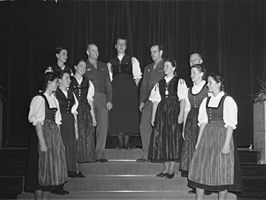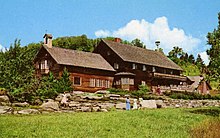How Many Kids Are in the Von Trapp Family
| The Trapp Family | |
|---|---|
 The Trapp Family in Jan 1946. | |
| Groundwork information | |
| Besides known as | The von Trapp Family unit; The Trapp Family unit Singers; The Trapp Family Choir |
| Origin | Salzburg, Republic of austria |
| Genres | vocal music, religious music, instrumental music |
| Years active | 1935–1957 |
| Labels | Victor, Decca, Deutsche Grammophon |
| Past members | Georg von Trapp Maria von Trapp Rupert von Trapp Agathe von Trapp Maria Franziska von Trapp Werner von Trapp Hedwig von Trapp Johanna von Trapp Martina von Trapp Johannes von Trapp |
The Trapp Family (likewise known as the von Trapp Family) were a singing grouping formed from the family of former Austrian naval commander Georg von Trapp. The family unit achieved fame in their original singing career in their native Austria during the interwar menstruation. They besides performed in the United states of america earlier emigrating there permanently to escape the deteriorating state of affairs in Austria during Earth War 2. In the U.s.a., they became well known as the "Trapp Family Singers" until they ceased to perform as a unit in 1957. The family's story later served as the footing for a memoir, 2 German films, and Rodgers and Hammerstein's Broadway musical The Sound of Music. The terminal surviving of the original seven Trapp children, Maria Franziska, died in 2014 at the age of 99.
Biography [edit]
History of the group [edit]


Maria and Georg Ludwig von Trapp
Georg von Trapp had seven children at the time of the decease of his first wife, Agathe Whitehead, and in 1927 he married Maria Kutschera, who was xx-five years his junior, and had three more than children with her. Both parts of the family were musical, and by 1935 the family unit was singing at the local church in Aigen, where they made the acquaintance of a immature priest, Dr Franz Wasner, who encouraged their musical progress and taught them sacred music to add to the folk songs, madrigals and ballads they were already singing.[i] While singing at their Salzburg domicile they were too heard by the German language concert singer Lotte Lehmann, who persuaded them to take part in the song competition at the 1936 Salzburg Festival, for which they won a prize; after this, accompanied by Dr Wasner, the family toured and performed in Vienna and Salzburg, and undertook a European tour that encompassed France, Belgium, the Netherlands, Italy, Germany and England.[1]
When Adolf Hitler annexed Austria in 1938, the family decided to leave, beginning for Italy (of which the Zadar-born Georg and thus the family were legally citizens). For some months in 1938, just after their flight, they lived in Warmond, near The Hague, Netherlands, equally the guests of a Dutch banker, Ernest Menten. This episode is described past local historian Miep Smitsloo in her 2007 Dutch book 'Tussen Tol en Trekvaart' ('Between Toll and Canal').[2] In her account of the flight, Maria von Trapp for some reason does non mention this stay. From in that location they went to London and then to the U.s.a., where they stayed until the expiration of their visas. Later on touring in Scandinavia, they returned to the United States on September 7, 1939 where they applied for immigrant condition. They arrived with very piddling money, having lost most of the family fortune before during a 1935 cyberbanking collapse in Austria. Once in the U.s.a. they earned money past performing and touring nationally and internationally, first as the "Trapp Family Choir" and and then, the "Trapp Family Singers", a change suggested by their booking amanuensis Frederick Christian Schang. Later living for a short time in Philadelphia[3] and so Merion, Pennsylvania, where their youngest child Johannes was born, the family settled in Stowe, Vermont, in 1941. They purchased a 660-acre (270 ha) farm in 1942 and converted it into the Trapp Family unit Lodge, initially chosen "Cor Unum". After World War II, they founded the Trapp Family unit Austrian Relief fund, which sent nutrient and wear to people impoverished in Republic of austria. By now based permanently in the U.s.a., the family performed their unique mixture of liturgical music, madrigals, folk music and instrumentals to audiences in over 30 countries for the next xx years.[4] They made a series of 78-rpm records for RCA Victor in the 1950s, some of which were later issued on RCA Camden LPs. There were also a few subsequently recordings released on LPs, including some stereo sessions. The family singing group disbanded in 1957.

The Trapp Family rehearsing earlier a concert, most Boston, 27 September 1941.

Cor Unum (later the "Trapp Family unit Lodge"), home of the Trapp Family Singers in the U.S., in 1954
Maria wrote an account of the singing family The Story of the Trapp Family unit Singers which was published in 1949 and was the inspiration for the 1956 West German pic The Trapp Family, which in plow inspired Rodgers and Hammerstein'southward Broadway musical The Sound of Music.[v] [6] The original seven Trapp children were: Rupert (1911–1992); Agathe (1913–2010); Maria Franziska (1914–2014); Werner (1915–2007); Hedwig (1917–1972); Johanna (1919–1994); and Martina (1921–1952). The later children were Rosmarie (b.1929), Eleonore (1931-2021), and Johannes (b.1939).[7] The eldest daughter, Agathe (chosen "Liesl" in the moving-picture show), published her own account of life in the Trapp family in 2003, Memories Before and After The Sound of Music,[viii] which was later itself turned into the motion picture The von Trapp Family: A Life of Music in 2015.[9]
Later lives [edit]
Two members of the group died while the grouping was still agile, Georg in 1947 at historic period 67, and Martina, who died in childbirth in 1952 at age 30. At the time of its cessation in 1957, the group included a number of non-family members because many of the original family wanted to pursue other endeavors, and only Maria's "fe will" had kept the group together for so long.[7] After the group's demise, Maria, Johannes, Rosmarie, and Maria Franziska went to New Guinea to do missionary work; later Maria returned to run the Trapp Family Order for a number of years.
Of the remaining children in their later years, Rupert was already a medical doctor during World War Two; Agathe spent many years as a kindergarten teacher in Maryland; Maria Franziska spent xxx years as a missionary in New Guinea; Werner became a farmer; Hedwig a music instructor; Johanna married and returned to Austria; Rosmarie and Eleonore both settled in Vermont; and Johannes followed his female parent past managing the Trapp Family unit Lodge as a tourist resort. Maria died in 1987 and was buried with Georg and Martina in the family unit cemetery on the property.[7] All of the original vii Trapp children had died by 2014, while but ii of the after 3 children built-in to Georg and Maria, Johannes and Rosmarie, are notwithstanding alive as of October 2021. Eleonore "Lorli" von Trapp Campbell died on October 17, 2021. [10]
Musical style and repertoire [edit]
The real-life Trapp family unit were a respected Austrian singing group throughout their career. However, their way was a world away from the Broadway and Hollywood crowd-pleasing popular numbers as afterward included in the musical and film versions of their lives. Many of their studio recordings survive and have been reproduced as contemporary CD compilations. As for their alive performances, in his 2004 essay Family values: The Trapp Family Singers in Due north America, 1938-1956, Michael Saffle writes:
It is hard to document today precisely what the Trapps performed and where they performed it. Only a very few of their programs have been reprinted. Ane of these—over again, a Christmas program—identifies an organization of 3 short pieces (for "Antique Instruments") and a Sonata by Sammartini (presented past a "Quintet of Recorders") every bit the evening's master instrumental selections; shorter song works included Praetorius's "Es ist ein Ros' entsprungen," a Monteverdi madrigal, Holst'south "Midwinter," and an arrangement of "The Holly and the Ivy." Another program—unfortunately incomplete, but known to have been presented in 1943 at Boston's Jordan Hall—featured a song by John Dowland, transcriptions by Wasner of Tyrolean folk tunes, and a Trio for two recorders and viola da gamba composed by "Werner von Trapp." In spite of their instrumental accomplishments, withal, the Trapps were above all a vocal ensemble that sang (and played) music together largely for religious reasons.[11]
On the other hand, press releases subsequent to 1941 advertised "rollicking folk songs of many lands," "gay, lilting madrigals," and "lusty yodels and mountain calls" also every bit "exquisite old motets and masses," and bragged of "record cross-land tour[south]" and big numbers of engagements,[11] which attested to their popular appeal and suggests that the religious content was only one of several contributing elements to this over their main menstruation of popularity in America.
Legacy [edit]
4 grandchildren of Werner von Trapp (chosen "Kurt" in the film), bully-grandchildren of Georg and step great-grandchildren of Maria, formed a singing group, "The von Trapps," and recorded five albums in a mod style betwixt 2001 and 2016 before disbanding.[12]
Partial discography [edit]
78 recordings [edit]
- Trapp Family unit Choir: Folk Songs of Central Europe - Dr. Franz Wasner, usher - Victor 78rpm set (5 records)
LP releases [edit]
- An Evening of Folk Songs with the Trapp Family Singers Decca DL 9793
- Christmas with the Trapp Family Singers Deutsche Grammophon, 1953
- The Best of the Trapp Family Singers Decca
- The Original Trapp Family Choir: The Sound Of Folk Music of Many Lands CAS904eLP33 1965 (compilation)
CD releases (compilations) [edit]
- The Sound of Christmas Delta Distribution / Laserlight, 1992
- Journey Jasmine (2 CDs)
- One Vocalization Jasmine (two CDs)
- Original Trapp Family Singers
References [edit]
- ^ a b Campbell, Elizabeth 1000., 2007: Introduction to English Translation of Georg von Trapp: "To the Last Salute: Memories of an Austrian U-Boat Commander". University of Nebraska Press, Lincoln, Nebraska.
- ^ "Sound of music in Warmond". DutchNews.nl. 2007-03-12. Retrieved 2021-12-26 .
- ^ "The Hills Are Alive... In Mt. Airy for $800K". 18 April 2018.
- ^ Singers.com: Trapp Family unit Singers
- ^ Peter Kerr (29 March 1987). "Maria von Trapp, Whose Life was 'Audio of Music', is Dead". New York Times . Retrieved 21 July 2007.
- ^ Bernhard, Marianne (1 October 1980). "Maria von Trapp speaks". Milwaukee Journal. (Washington Post). p. half-dozen, part 1.
- ^ a b c Prologue Magazine: Flick vs. Reality: The Existent Story of the Von Trapp Family unit
- ^ Good Reads: Agathe Von Trapp: Memories Before and After the Sound of Music
- ^ common sense media: The Von Trapp Family unit: A Life of Music. Movie review by Renee Schonfeld, Common Sense Media
- ^ "Correction: Obit--Von Trapp Daughter story". Associated Press. 21 October 2021.
- ^ a b Saffle. Michael. 2004. "Family unit Values: The Trapp Family unit Singers in Northward America, 1938-1956". Canadian University Music Review 24 (2), 62–79. Doi: 10.7202/1014583ar.
- ^ Country Living: Megan Friedman Mar 23, 2016: The Von Trapp Family is Proverb Then Long, Bye to Music
External links [edit]
- History of the von Trapp Family (from the Trapp Family Lodge website)
- Maria von Trapp interview on BBC Radio iv Desert Island Discs, 29 Dec 1983
Source: https://en.wikipedia.org/wiki/Trapp_Family
Belum ada Komentar untuk "How Many Kids Are in the Von Trapp Family"
Posting Komentar